
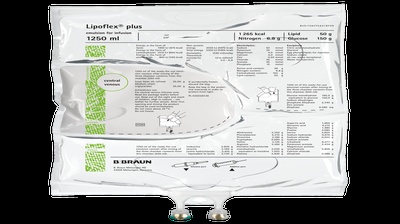
ЛІПОФЛЕКС ПЛЮС ЕМУЛЬСІЯ ДЛЯ ПЕРФУЗІЇ

Запитайте лікаря про рецепт на ЛІПОФЛЕКС ПЛЮС ЕМУЛЬСІЯ ДЛЯ ПЕРФУЗІЇ

Інструкція із застосування ЛІПОФЛЕКС ПЛЮС ЕМУЛЬСІЯ ДЛЯ ПЕРФУЗІЇ
Введення
Опис: інформація для користувача
Ліпофлекс плюс емульсія для перфузії ЕФГ
Прочитайте уважно весь опис перед тим, як почнете використовувати цей лікарський засіб, оскільки він містить важливу інформацію для вас.
- Збережіть цей опис, оскільки вам може знадобитися знову його прочитати. Якщо у вас виникли питання, проконсультуйтеся з вашим лікарем, фармацевтом або медсестрою.
- Цей лікарський засіб призначений тільки для вас, і не слід давати його іншим людям, навіть якщо вони мають相同ні симптоми, оскільки це може їм нашкодити.
- Якщо ви відчуваєте побічні ефекти, проконсультуйтеся з вашим лікарем, фармацевтом або медсестрою, навіть якщо це побічні ефекти, які не вказані в цьому описі. Див. розділ 4.
Зміст опису
- Що таке Ліпофлекс плюс і для чого він використовується
- Що вам потрібно знати перед тим, як почнете використовувати Ліпофлекс плюс
- Як використовувати Ліпофлекс плюс
- Можливі побічні ефекти
- Зберігання Ліпофлекс плюс
- Зміст упаковки та додаткова інформація
1. Що таке Ліпофлекс плюс і для чого він використовується
Ліпофлекс плюс містить рідини та речовини, звані амінокислотами, електролітами та жирними кислотами, які є необхідними для росту чи відновлення організму. Він також містить калорії у вигляді вуглеводів та жирів.
Цей лікарський засіб застосовується, коли існує неможливість приймати харчування нормальним чином. Існує багато ситуацій, у яких це може трапитися, наприклад, під час відновлення після хірургічних операцій, травм або опіків чи коли існує неможливість всмоктування харчових речовин у шлунку та кишечнику.
Ця емульсія може бути застосована для дорослих, підлітків та дітей старше 2 років.
2. Що вам потрібно знати перед тим, як почнете використовувати Ліпофлекс плюс
Не використовуйте Ліпофлекс плюс
якщо ви алергічні на один з активних компонентів, яйця, арахіс або сою чи на один з інших компонентів цього лікарського засобу (перелічених у розділі 6),
цей лікарський засіб не повинен бути застосований для новонароджених, немовлят та дітей молодше 2 років.
Також не використовуйте цей лікарський засіб, якщо у вас є один з наступних розладів:
потенційно смертельні проблеми з циркуляцією крові, наприклад, у випадку колапсу чи шоку,
інфаркт міокарда або інсульт,
важка дисфункція згортання крові, ризик кровотечі (важка коагулопатія, геморагічні діатези),
блокування крові в судинах через кров'яні згортки або жир (емболія),
важка печінкова недостатність,
порушення білкової функції (інтраґепатична холестаз),
важка ниркова недостатність, при якій немає доступу до апаратів для діалізу,
порушення складу солей в організмі,
дéficit рідини або надмірна кількість води в організмі,
вода в легенях (пульмонний едема),
важка серцева недостатність,
певні метаболічні розлади, наприклад:
- збільшення кількості жирів у крові,
- вроджені порушення метаболізму амінокислот,
- анормально високий рівень цукру в крові, який потребує більше 6 одиниць інсуліну на годину для контролю,
- порушення метаболізму, які можуть виникнути після хірургічних операцій або травм,
- кома невідомої етіології,
- недостатнє надходження кисню до тканин,
- анормально високий рівень кислот у крові.
Попередження та застереження
Проконсультуйтеся з вашим лікарем, фармацевтом або медсестрою перед тим, як почнете використовувати Ліпофлекс плюс.
Повідомте вашого лікаря, якщо:
у вас є серцеві, печінкові або ниркові проблеми,
у вас є певні метаболічні розлади, наприклад, цукровий діабет, аномальні рівні жирів у крові та порушення складу рідини та солей у організмі чи кислотно-лужного балансу.
Вас буде піддано уважному контролю для виявлення перших ознак алергічної реакції (таких як гарячка, озноб, висипка на шкірі чи задишка) під час застосування цього лікарського засобу.
Вас буде піддано додатковому контролю та проведенню аналізів, таких як різні дослідження крові, для забезпечення того, що ваш організм правильно засвоює харчові речовини.
Медичний персонал також може вжити заходів для забезпечення того, щоб ваш організм мав достатню кількість рідини та електролітів. Крім цього лікарського засобу, вам можуть бути призначені додаткові харчові речовини (харчування) для забезпечення повного задоволення ваших потреб.
Діти
Цей лікарський засіб не повинен бути застосований для новонароджених, немовлят та дітей молодше 2 років.
Застосування Ліпофлекс плюс з іншими лікарськими засобами
Повідомте вашого лікаря, фармацевта або медсестру, якщо ви приймаєте, нещодавно приймали або можете приймати інші лікарські засоби.
Ліпофлекс плюс може взаємодіяти з деякими лікарськими засобами. Повідомте вашого лікаря, фармацевта або медсестру, якщо ви приймаєте або отримуєте будь-які з наступних лікарських засобів:
інсулін,
гепарин,
лікарські засоби, які запобігають незвичайному згортанню крові, наприклад, варфарин або інші кумаринові похідні,
лікарські засоби, які сприяють виділенню сечі (діуретики),
лікарські засоби для лікування артеріальної гіпертензії (інгібітори АПФ),
лікарські засоби для лікування артеріальної гіпертензії або серцевих проблем (антагоністи рецепторів ангіотензину-ІІ),
лікарські засоби, які використовуються при трансплантації органів, наприклад, циклоспорин та такролімус,
лікарські засоби для лікування запалення (кортикостероїди),
гормональні препарати, які впливають на ваш водний баланс (адренокортикотропний гормон або АКТГ).
Вагітність та лактація
Якщо ви вагітні або перебуваєте у період лактації, вважаєте, що можете бути вагітною або плануєте завагітніти, проконсультуйтеся з вашим лікарем або фармацевтом перед тим, як використовувати цей лікарський засіб. Якщо ви вагітні, ви отримаєте цей лікарський засіб лише у випадку, якщо лікар або фармацевт вважає це абсолютно необхідним для вашої відновлення. Немає даних про застосування Ліпофлекс плюс у вагітних жінок.
Не рекомендується лактація у матерів, які отримують парентеральне харчування.
Водіння транспортних засобів та використання машин
Цей лікарський засіб зазвичай застосовується у пацієнтів, які перебувають у стаціонарі, наприклад, у лікарні або клініці, що виключає можливість водіння транспортних засобів або використання машин. Однак сам лікарський засіб не має впливу на здатність водити транспортні засоби або використовувати машини.
Ліпофлекс плюс містить натрій
Цей лікарський засіб містить 1 150 мг натрію (основної складової кухонної солі) у кожній сумці об'ємом 1 250 мл. Це відповідає 58% від максимальної добової норми споживання натрію, рекомендованої для дорослих.
Максимальна добова доза цього лікарського засобу містить 2 580 мг натрію (кitchen солі). Це відповідає 129% від максимальної добової норми споживання натрію, рекомендованої для дорослих.
Проконсультуйтеся з вашим лікарем або фармацевтом, якщо вам потрібно приймати одну або кілька сумок цього лікарського засобу на добу протягом тривалого періоду, особливо якщо вам рекомендовано дієта з низьким вмістом солі (натрію).
3. Як використовувати Ліпофлекс плюс
Цей лікарський засіб застосовується шляхом внутрішньовенної інфузії (крапля за краплею), тобто через малий трубку безпосередньо у вену. Цей лікарський засіб буде застосовуватися лише через одну з ваших великих вен (центральних).
Ваш лікар або фармацевт вирішить, яку кількість цього лікарського засобу вам потрібно та на який період часу вам потрібно лікування цим засобом.
Застосування у дітей
Цей лікарський засіб не повинен бути застосований для новонароджених, немовлят та маленьких дітей молодше 2 років.
Ваш лікар вирішить, яку кількість цього лікарського засобу потрібно вашій дитині та на який період часу ваша дитина потребує лікування цим засобом.
Якщо ви прийняли більше Ліпофлекс плюс, ніж потрібно
Якщо ви отримали надмірну кількість цього лікарського засобу, ви можете відчувати так званий "синдром надмірної кількості" та наступні симптоми:
надмірна кількість рідини та порушення електролітного балансу,
вода в легенях (пульмонний едема),
втрата амінокислот через сечу та порушення амінокислотного балансу,
воміта, нудота,
тремор,
високий рівень цукру в крові,
глюкоза в сечі,
дéficit рідини,
гіперосмоляльність крові,
порушення або втрата свідомості через надмірно високий рівень цукру в крові,
збільшення печінки (гепатомегалія) з або без жовтяниці,
збільшення селезінки (спленомегалія),
відкладення жиру в внутрішніх органах,
аномальні показники функції печінки,
зниження кількості червоних кров'яних тілечок (анемія),
зниження кількості білих кров'яних тілечок (лейкопенія),
зниження кількості тромбоцитів (тромбоцитопенія),
збільшення кількості незрілих червоних кров'яних тілечок (ретикулоцитоз),
розпад кров'яних клітин (гемоліз),
кровотеча або схильність до кровотечі,
порушення згортання крові (як можна побачити за змінами часу згортання крові, часу протромбіну тощо),
гарячка,
високий рівень жирів у крові,
втрата свідомості.
Якщо виникає будь-який з цих симптомів, інфузію слід негайно припинити.
Якщо у вас виникли інші питання щодо застосування цього лікарського засобу, проконсультуйтеся з вашим лікарем або фармацевтом.
4. Можливі побічні ефекти
Як і всі лікарські засоби, цей лікарський засіб може викликати побічні ефекти, хоча не всі люди їх відчувають.
Наступні побічні ефекти можуть бути серйозними. Якщо ви відчуваєте будь-який з цих побічних ефектів, негайно повідомте вашого лікаря, який припинить застосування цього лікарського засобу:
Рідкі (можуть виникнути у до 1 особи з 1 000):
алергічні реакції, наприклад, реакції шкіри, задишка, набряк губ, рота та горла, труднощі з диханням,
Інші побічні ефекти включають:
Небагато поширені (можуть виникнути у до 1 особи з 100):
нудота, воміта, втрата апетиту,
Рідкі (можуть виникнути у до 1 особи з 1 000):
збільшення схильності до згортання крові,
синюшність шкіри,
задишка,
головний біль,
червоність обличчя,
еритема,
потіння,
озноб,
чувство холоду,
високая температура тіла,
сонливість,
біль у грудях, спині, кістках чи попереку,
зниження або збільшення артеріального тиску.
Дуже рідкі (можуть виникнути у до 1 особи з 10 000):
аномально високий рівень цукру або жирів у крові,
підвищений рівень кислот у крові,
надмірна кількість ліпідів може викликати синдром надмірної кількості; для більшої інформації див. розділ "Якщо ви прийняли більше Ліпофлекс плюс, ніж потрібно" у розділі 3. Симптоми зазвичай зникають після припинення інфузії.
Частота невідома (не може бути оцінена на основі доступних даних):
зниження кількості білих кров'яних тілечок (лейкопенія),
зниження кількості тромбоцитів (тромбоцитопенія),
порушення жовчної функції (холестаз).
Повідомлення про побічні ефекти
Якщо ви відчуваєте будь-який побічний ефект, проконсультуйтеся з вашим лікарем, фармацевтом або медсестрою, навіть якщо це побічні ефекти, які не вказані в цьому описі. Ви також можете повідомити про них безпосередньо через систему моніторингу лікарських засобів (www.notificaRAM.es)
5. Зберігання Ліпофлекс плюс
Тримайте цей лікарський засіб поза досяжністю дітей.
Не зберігайте при температурі вище 25 °C.
Не заморожуйте. Виведіть сумку з обігу, якщо вона була заморожена випадково.
Тримайте сумку в зовнішній упаковці для захисту від світла.
Не використовуйте цей лікарський засіб після закінчення терміну придатності, вказаного на етикетці. Термін придатності - останній день місяця, вказаного на етикетці.
6. Зміст упаковки та додаткова інформація
Склад Ліпофлекс плюс
Активні речовини суміші, готової до використання, є:
Від верхньої камери (розчин глюкози) | у 1 000 мл | у 1 250 мл | у 1 875 мл | у 2 500 мл |
Глюкоза моногідрат | 132,0 г | 165,0 г | 247,5 г | 330,0 г |
еквівалент глюкози | 120,0 г | 150,0 г | 225,0 г | 300,0 г |
Дигідрогенфосфат натрію дигідрат | 1,872 г | 2,340 г | 3,510 г | 4,680 г |
Ацетат цинку дигідрат | 5,264 мг | 6,580 мг | 9,870 мг | 13,16 мг |
Від середньої камери (жирова емульсія) | у 1 000 мл | у 1 250 мл | у 1 875 мл | у 2 500 мл |
Рафінована сояна олія | 20,00 г | 25,00 г | 37,50 г | 50,00 г |
Тригліцериди середньої ланцюга | 20,00 г | 25,00 г | 37,50 г | 50,00 г |
Від нижньої камери (розчин амінокислот) | у 1 000 мл | у 1 250 мл | у 1 875 мл | у 2 500 мл |
Ізолейцин | 2,256 г | 2,820 г | 4,230 г | 5,640 г |
Лейцин | 3,008 г | 3,760 г | 5,640 г | 7,520 г |
Хлорид лізину еквівалент лізину | 2,728 г 2,184 г | 3,410 г 2,729 г | 5,115 г 4,094 г | 6,820 г 5,459 г |
Метіонін | 1,880 г | 2,350 г | 3,525 г | 4,700 г |
Фенілаланін | 3,368 г | 4,210 г | 6,315 г | 8,420 г |
Треонін | 1,744 г | 2,180 г | 3,270 г | 4,360 г |
Триптофан | 0,544 г | 0,680 г | 1,020 г | 1,360 г |
Валін | 2,496 г | 3,120 г | 4,680 г | 6,240 г |
Аргінін | 2,592 г | 3,240 г | 4,860 г | 6,480 г |
Хлорид гістидину моногідрат еквівалент гістидину | 1,624 г 1,202 г | 2,030 г 1,503 г | 3,045 г 2,255 г | 4,060 г 3,005 г |
Аланін | 4,656 г | 5,820 г | 8,730 г | 11,64 г |
Аспарагінова кислота | 1,440 г | 1,800 г | 2,700 г | 3,600 г |
Глутамінова кислота | 3,368 г | 4,210 г | 6,315 г | 8,420 г |
Гліцин | 1,584 г | 1,980 г | 2,970 г | 3,960 г |
Пролін | 3,264 г | 4,080 г | 6,120 г | 8,160 г |
Серін | 2,880 г | 3,600 г | 5,400 г | 7,200 г |
Гідроксид натрію | 0,781 г | 0,976 г | 1,464 г | 1,952 г |
Хлорид натрію | 0,402 г | 0,503 г | 0,755 г | 1,006 г |
Ацетат натрію трігідрат | 0,222 г | 0,277 г | 0,416 г | 0,554 г |
Ацетат калію | 2,747 г | 3,434 г | 5,151 г | 6,868 г |
Ацетат магнію тетрагідрат | 0,686 г | 0,858 г | 1,287 г | 1,716 г |
Хлорид кальцію дигідрат | 0,470 г | 0,588 г | 0,882 г | 1,176 г |
Електроліти | у 1 000 мл | у 1 250 мл | у 1 875 мл | у 2 500 мл |
Натрій | 40 ммоль | 50 ммоль | 75 ммоль | 100 ммоль |
Калій | 28 ммоль | 35 ммоль | 52,5 ммоль | 70 ммоль |
Магній | 3,2 ммоль | 4,0 ммоль | 6,0 ммоль | 8,0 ммоль |
Кальцій | 3,2 ммоль | 4,0 ммоль | 6,0 ммоль | 8,0 ммоль |
Цинк | 0,024 ммоль | 0,03 ммоль | 0,045 ммоль | 0,06 ммоль |
Хлорид | 36 ммоль | 45 ммоль | 67,5 ммоль | 90 ммоль |
Ацетат | 36 ммоль | 45 ммоль | 67,5 ммоль | 90 ммоль |
Фосфат | 12 ммоль | 15 ммоль | 22,5 ммоль | 30 ммоль |
Вміст амінокислот | 38 г | 48 г | 72 г | 96 г |
Вміст азоту | 5,4 г | 6,8 г | 10,2 г | 13,7 г |
Вміст вуглеводів | 120 г | 150 г | 225 г | 300 г |
Вміст жирів | 40 г | 50 г | 75 г | 100 г |
Енергія у вигляді жирів | 1 590 кДж (380 ккал) | 1 990 кДж (475 ккал) | 2 985 кДж (715 ккал) | 3 980 кДж (950 ккал) |
Енергія у вигляді вуглеводів | 2 010 кДж (480 ккал) | 2 510 кДж (600 ккал) | 3 765 кДж (900 ккал) | 5 020 кДж (1 200 ккал) |
Енергія у вигляді амінокислот | 635 кДж (150 ккал) | 800 кДж (190 ккал) | 1 200 кДж (285 ккал) | 1 600 кДж (380 ккал) |
Непротеїнова енергія | 3 600 кДж (860 ккал) | 4 500 кДж (1 075 ккал) | 6 750 кДж (1 615 ккал) | 9 000 кДж (2 150 ккал) |
Загальна енергія | 4 235 кДж (1 010 ккал) | 5 300 кДж (1 265 ккал) | 7 950 кДж (1 900 ккал) | 10 600 кДж (2 530 ккал) |
Осмолальність | 1 540 мОсм/кг | 1 540 мОсм/кг | 1 540 мОсм/кг | 1 540 мОсм/кг |
Теоретична осмолярність | 1 215 мОсм/л | 1 215 мОсм/л | 1 215 мОсм/л | 1 215 мОсм/л |
рН | 5,0 – 6,0 | 5,0 – 6,0 | 5,0 – 6,0 | 5,0 – 6,0 |
Інші компоненти - цитринова кислота моногідрат (для регулювання рН), ліпіди яєчного дрозу для ін'єкцій, гліцерол, олеат натрію, альфа-токоферол і вода для ін'єкцій.
Вигляд продукту та вміст упаковки
Готовий до використання продукт - це емульсія для перфузії, тобто вводиться через малий трубку в вену.
Ліпофлекс плюс постачається у гнучких багатокамерних мішках, які містять:
- 1 250 мл (500 мл розчину амінокислот + 250 мл жирової емульсії + 500 мл розчину глюкози),
- 1 875 мл (750 мл розчину амінокислот + 375 мл жирової емульсії + 750 мл розчину глюкози),
2 500 мл (1 000 мл розчину амінокислот + 500 мл жирової емульсії + 1 000 мл розчину глюкози).
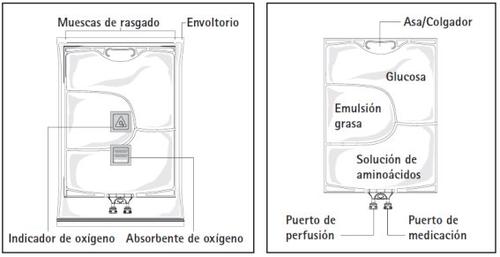
Фігура А Фігура Б
Фігура А: Мішка багатокамерна вводиться в захисну оболонку. Між мішкою та оболонкою знаходяться абсорбент кисню та індикатор кисню; пакет абсорбенту кисню виготовлений з інертного матеріалу та містить гідроксид заліза.
Фігура Б: Верхня камера містить розчин глюкози, середня камера містить жирову емульсію, а нижня камера містить розчин амінокислот.
Розчини глюкози та амінокислот прозорі та мають колір від безколірного до світло-жовтого. Жирова емульсія має колір білого молока.
Верхня та середня камери можна з'єднати з нижньою, відкриваючи проміжні шви (від'єднувальні шви).
Конструкція мішка дозволяє змішувати амінокислоти, глюкозу, жири та електроліти в одну камеру. Після відкриття від'єднувальних швів утворюється стерильна суміш, яка формує емульсію.
Різні розміри упаковки подаються в коробках, які містять п'ять мішок.
Розміри упаковки: 5 × 1 250 мл, 5 × 1 875 мл та 5 × 2 500 мл
Можливо, що тільки деякі розміри упаковки будуть продаватися.
Власник дозволу на розміщення продукції на ринку:
- Braun Melsungen AG
Carl-Braun-Str. 1 Поштова адреса:
34212 Мельзунген, Німеччина 34209 Мельзунген, Німеччина
Тел.: +49-(0)-5661-71-0
Факс: +49-(0)-5661-71-4567
Виробник
- Braun Melsungen AG
Am Schwerzelshof 1
34 212 Мельзунген
Німеччина
Для отримання додаткової інформації щодо цього лікарського засобу зверніться до місцевого представника власника дозволу на розміщення продукції на ринку
- Braun Medical, S.A.
Ctra. de Terrassa, 121
08191 Рубі, Іспанія
Цей лікарський засіб дозволений до застосування в державах-членах Європейського економічного просторута у Великій Британії (Північна Ірландія)під наступними назвами:
Австрія Nutriflex Lipid plus B.Braun
Бельгія Nutriflex Lipid plus, 38 г/л АК + 120 г/л Г, емульсія для інфузії
Данія Ліпофлекс Плюс
Фінляндія Nutriflex Lipid 38/120/40
Франція LIPOFLEX LIPIDE G120/N 5,4 /E, емульсія для перфузії
Німеччина Nutriflex Lipid 38/120 плюс
Ісландія Nutriflex Lipid 38/120 плюс
Італія Ліпофлекс АА38/Г120
Люксембург Nutriflex Lipid 38/120 плюс
Нідерланди Nutriflex Lipid plus, 38 г/л + 120 г/л, емульсія для інфузії
Норвегія Ліпофлексплюс
Польща Ліпофлекс плюс
Румунія Ліпофлекс плюс емульсія для перфузії
Іспанія Ліпофлекс плюс емульсія для перфузії
Швеція Nutriflex Lipid 38/120/40
Велика Британія (Північна Ірландія) Ліпофлекс плюс емульсія для інфузії
Дата останнього перегляду цього листка:
09/2023
Детальна інформація про цей лікарський засіб доступна на сайті Іспанського агентства лікарських засобів та медичних продуктів (AEMPS) (http://www.aemps.gob.es/)
______________________________________________________________________________
Ця інформація призначена лише для медичних працівників:
Не потрібні особливі умови для видалення.
Продукти парентерального харчування повинні бути візуально перевірені перед використанням для виявлення пошкоджень, змін кольору та нестабільності емульсії.
Не використовувати мішки з пошкодженнями. Оболонка, основна мішка та від'єднувальні шви між камерами повинні бути цілими. Використовувати лише якщо розчини амінокислот та глюкози прозорі та мають колір від безколірного до світло-жовтого, а жирова емульсія однорідна та має колір білого молока. Не використовувати, якщо розчини містять частинки.
Після змішування трьох камер не використовувати, якщо емульсія має зміни кольору або ознаки розділення фаз (краплі олії, шар олії). Зупинити перфузію негайно у разі зміни кольору емульсії або ознак розділення фаз.
Перед відкриттям оболонки перевірити колір індикатора кисню (див. Фігура А). Не використовувати, якщо індикатор кисню змінює колір на рожевий. Використовувати лише якщо індикатор кисню жовтий.
Підготовка змішаної емульсії
Необхідно дотримуватися суворих принципів асептичної обробки.
Для відкриття: відкрити оболонку, починаючи з надрізів (Фігура 1). Видалити мішку з захисної оболонки. Видалити оболонку, індикатор кисню та абсорбент кисню.
Візуально перевірити основну мішку на наявність витоків. Мішки з витоками повинні бути видалені, оскільки їх стерильність не може бути гарантована.
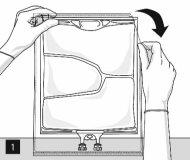
Змішування мішки та додавання добавок
Для відкриття та змішування камер послідовно згорнути мішку обома руками, відкриваючи спочатку від'єднувальний шов, який розділяє верхню камеру (глюкоза) та нижню камеру (амінокислоти) (Фігура 2).
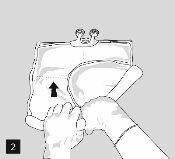
Після видалення алюмінієвої плівки (Фігура 3) можна додавати гідросольові добавки, сумісні з продуктом, через порт медикаментів (Фігура 4) до прозорих водних розчинів. Добре перемішати вміст мішки (Фігура 5) та візуально перевірити суміш на наявність осадів (Фігура 6). Використовувати лише якщо розчин прозорий.
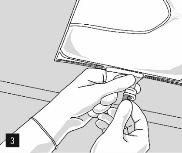
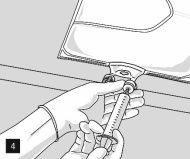
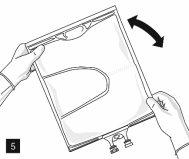

Далі слід застосовувати тиск так, щоб відкрився від'єднувальний шов, який розділяє середню камеру (жири) та нижню камеру (Фігура 7). Суміш являє собою однорідну емульсію олії у воді білого молочного кольору. Після змішування всіх камер можна додавати сумісні добавки через порт медикаментів (Фігура 4). Добре перемішати вміст мішки (Фігура 8) та візуально перевірити суміш (Фігура 9).
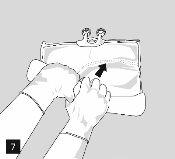
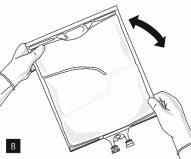
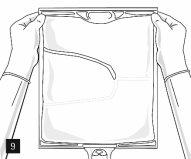
Виробник може надати, за запитом, дані про сумісність різних добавок (наприклад, електролітів, олігоелементів, вітамінів) та відповідні терміни їхньої валідності.
Підготовка до перфузії
Емульсію завжди слід зберігати при кімнатній температурі перед перфузією.
Видалити алюмінієву плівку (Фігура 10) з порту перфузії та підключити обладнання для перфузії (Фігура 11). Використовувати обладнання для перфузії без вентиляції або закрити вентиляцію повітря, якщо використовується обладнання з вентиляцією. Підвісити мішку на гак для перфузії (Фігура 12) та виконати перфузію згідно зі стандартною технікою.
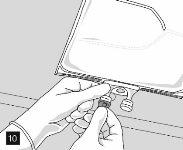
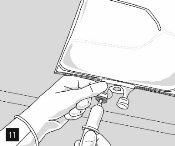
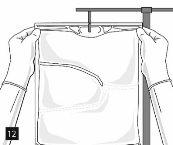
Для одного використання. Упаковку та невикористані залишки слід видалити після використання.
Не перез'єднувати частково використані упаковки.
Якщо використовуються фільтри, вони повинні бути проникними для жирів (розмір пор ≥ 1,2 мкм).
Термін валідності після видалення захисної оболонки та після змішування вмісту мішки
Показано хімічну та фізико-хімічну стабільність суміші амінокислот, глюкози та жирів під час використання протягом 7 днів при 2-8 °C та протягом 2 додаткових днів при 25 °C.
Термін валідності після додаткового змішування сумісних добавок
З мікробіологічної точки зору продукт слід використовувати негайно після додаткового змішування добавок. В іншому випадку терміни зберігання під час використання та умови перед цим є відповідальністю користувача.
Емульсію слід використовувати негайно після відкриття упаковки.
Рекомендована тривалість перфузії однієї мішки парентерального харчування становить максимум 24 години.
Цей лікарський засіб не слід змішувати з іншими лікарськими засобами, сумісність яких не була задокументована.
Цей лікарський засіб не слід вводити одночасно з кров'ю в одному обладнанні для перфузії через ризик псевдоаглютинації.
- Країна реєстрації
- Діючі речовини
- Потрібен рецептТак
- Виробник
- Інформація є довідковою і не є медичною порадою. Перед прийомом будь-яких препаратів обов'язково проконсультуйтеся з лікарем. Oladoctor не несе відповідальності за медичні рішення, прийняті на основі цього контенту.
- Альтернативи до ЛІПОФЛЕКС ПЛЮС ЕМУЛЬСІЯ ДЛЯ ПЕРФУЗІЇФорма випуску: ІН'ЄКЦІЙНИЙ РОЗЧИН ДЛЯ ІНФУЗІЙ, 3,92 г / 1,26 г / 7,21 г / 3,36 г / 4,2 г / 5,11 г / 2,94 г / 2,8 г / 4,76 г / 5,07 г / 4,06 г / 14,49 г / 0,28 г / 8,05 г / 3,5 г / 200 гДіючі речовини: combinationsВиробник: Baxter S.L.Потрібен рецептФорма випуску: ІН'ЄКЦІЙНИЙ РОЗЧИН ДЛЯ ІНФУЗІЙ, 3,5 г / 200 г / 5,22 г / 1,88 г / 3,92 г / 1,26 г / 7,21 г / 3,36 г / 4,2 г / 5,11 г / 2,94 г / 2,8 г / 662 мг / 1,02 г / 4,76 г / 5,15 г / 5,07 г / 4,06 г / 14,49 г / 0,28 г / 8,05 гДіючі речовини: combinationsВиробник: Baxter S.L.Потрібен рецептФорма випуску: ІН'ЄКЦІЙНИЙ РОЗЧИН ДЛЯ ІНФУЗІЙ, 4,25 г / 300 г / 5,22 г / 1,54 г / 4,76 г / 1,53 г / 8,76 г / 4,08 г / 5,1 г / 6,2 г / 3,57 г / 3,4 г / 662 мг / 1,02 г / 5,78 г / 5,94 г / 6,16 г / 4,93 г / 17,6 г / 0,34 г / 9,78 гДіючі речовини: combinationsВиробник: Baxter S.L.Потрібен рецепт
Аналоги ЛІПОФЛЕКС ПЛЮС ЕМУЛЬСІЯ ДЛЯ ПЕРФУЗІЇ в інших країнах
Найкращі аналоги з тією самою діючою речовиною та терапевтичним ефектом.
Аналог ЛІПОФЛЕКС ПЛЮС ЕМУЛЬСІЯ ДЛЯ ПЕРФУЗІЇ у Польша
Аналог ЛІПОФЛЕКС ПЛЮС ЕМУЛЬСІЯ ДЛЯ ПЕРФУЗІЇ у Украина
Лікарі онлайн щодо ЛІПОФЛЕКС ПЛЮС ЕМУЛЬСІЯ ДЛЯ ПЕРФУЗІЇ
Консультація щодо дозування, побічних ефектів, взаємодій, протипоказань та поновлення рецепта на ЛІПОФЛЕКС ПЛЮС ЕМУЛЬСІЯ ДЛЯ ПЕРФУЗІЇ – за рішенням лікаря та згідно з місцевими правилами.














